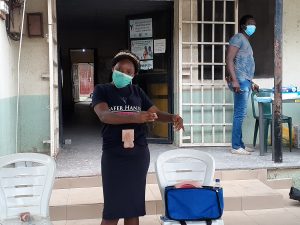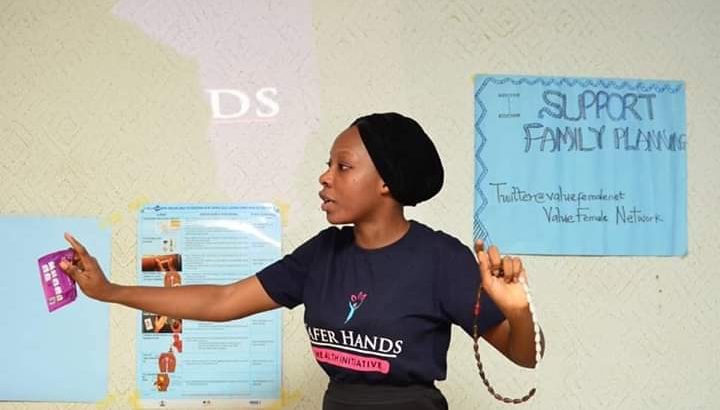Globally and in Nigeria, today – September 26 – annually marks the World Contraception Day. According to the international family planning organizations that initiated this day, it was set aside to increase awareness about the various types of contraceptives available with a mission to enable individuals (especially young people) make informed choices about their sexual and reproductive health towards a world where every pregnancy is planned and wanted.
Unintended pregnancy – is a pregnancy that either occurred when no child, or no more children, were desired (that is, unwanted) or a pregnancy that occurred earlier than desired (that is, mistimed which could also be unplanned). The major cause of these are through sexual activities without the use of effective family planning.
What is Contraception?
Contraception, generally known as “Family Planning” (FP), but more recently as “Life Planning” among adolescents and youths can be described as a concept that covers services, policies, information, attitudes, practices, and commodities, including contraceptives majorly; which enable women, men, couples, adolescents and young people to choose whether or not to have a child by avoiding unintended pregnancy, when to have a child (spacing) and how many child/children (number) to have (Starbird, et al 2016).
There are different methods of FP which could be modern or traditional. Modern methods include; oral contraceptive pills (combined or progesterone-only), implants (single & double rods), injectables (monthly, progesterone-only or combined), contraceptive patch and vaginal ring, intrauterine device (IUD), female and male condoms, female and male sterilization (bilateral tubal ligation and vasectomy respectively), vaginal barrier methods (including the diaphragm, cervical cap and spermicidal agents – cream, jelly, form and sponge), lactational amenorrhea method (LAM) and emergency contraception pills.
Traditional methods include; fertility awareness-based methods and periodic abstinence – standard days method (SDM), basal body temperature (BBT) method, TwoDay Method, Sympto-thermal Method, Calendar or rhythm method – and Coitus interruptus (withdrawal method) (UNDESA 2019, WHO 2020).
Men benefit from FP by having financial, mental and psychological freedom to provide for their “small planned families” as opposed to pressure & disability associated with providing for “large unplanned families”. Women benefit numerously from FP by allowing their body time to rejuvenate, mind to be productive at other things – rather than always “bearing and rearing” kids – and for the children, resources to be taken care of at every given time. Also the community benefits from FP, because “only unplanned children turn out as thugs disturbing the peace of the nation”.
Why The Constant Awareness About Contraception?
Family planning cannot be overemphasized because it is a very important part of global health – as one of the most significant intervention for maternal and child health in recent times – with its impact transcending across different levels and sectors of global and national structures including the Sustainable Development Goals (SDGs). FP prevents health risks associated with pregnancy and delivery for women, girls and infants. Beyond its role in planning or stopping child birth for females and couples, it also has a wide range of benefits for families, communities, nations and the globe as a whole – including economic development, education and empowerment, good health, wellbeing and survival of a sustainable populace (Starbird, et al 2016, Izugbara, et al 2018, WHO 2020).
Contraception use achieve some these benefits by supporting human rights; such as the girl-child, adolescent boys and girls right to information on how unplanned pregnancies affects their future and supporting all peoples right to accurate, unbiased information on FP methods that can help them achieve their reproductive desires, which escalates into achieving their socio-economic and educational desires. By reduction of poorly planned or unplanned overpopulation or rapid population growth (through controlled household sizes) which helps to reduce poor sanitation, air pollution, increased transmission of Airborne and faeco-oral infectious diseases (e.g. Tuberculosis, Cholera), Neglected tropical diseases (e.g. Scabies) malnutrition and insufficient resources associated with overcrowded households. Also, lowering the number of dependents and expanding the size of income earners in the population to achieve a demographic dividend for rapid economic growth and ultimately eradicating poverty (UN SDG Report 2018, 2019, Starbird, et al 2019)
Reproductive age – Is between the age of 15 – 49 when the reproductive hormonal activities are occurring in females and fertility rates are at its peak among the male and female population (married, in a union or unmarried). These age group makes a bulk of the global working population (Kantorová, et al 2020).
Contraception Use: The Global Unmet Need of FP
In 2019, approximately 300 million women-in-reproductive-age (with 16% as unmarried woman) had an unmet need for FP; out of the 1.9 billion total population of women-in-reproductive-age globally (Kantorová, et al 2020). Also, from the 2018 & 2019 UN SDGs report, over 300,000 mothers still die globally from complication of pregnancy and childbirth, while the babies have higher tendencies for low birth weight, preterm birth and other co-morbidities. In addition, a large part of these maternal and infant deaths and extreme morbidity outcomes such as unsafe abortions, fistulas – resulting from birth to adolescent mothers, elderly mothers, mothers with great health risk, closely-spaced and high-risk births – causes societal stigmatization, social exclusion and reduction in social capital (Izugbara, et al 2018, Atchison, et al 2018).
Furthermore, the unmet need for modern method of FP globally was reportedly 14.2% in 2019 (Kantorová, et al 2020). One of these methods (use of male and female condoms) asides from preventing pregnancy is also able to prevent STIs including HIV/AIDS. Overtime, HIV/AIDS has been one of the most focused top10 issues of global health worldwide, accounting for a high disease incidence, morbidity and mortality rate; especially among the reproductive age group (WHO 2020, GHO 2021). These increase in the global burden of disease and death rate among the reproductive working population – with its associated direct and indirect cost – could have been averted by adequate uptake of FP and can be significantly reduced with the correct, consistent and continuous use of the barrier methods of FP among them.
Unmet need for family planning – Is the number or percentage of women who want to stop or delay childbearing for at least 2 years but are not using any contraceptive method to prevent pregnancy (Kantorová, et al 2020)
Where Are We As A Nation?
In West Africa pre-COVID (Nigeria inclusive), high proportions of women-in-reproductive-age (married and unmarried) continue to experience unmet need for modern methods, low contraceptive rates with their associated problems, which is worse in the northern region. More representative statistics in recent times collated from 307 PHCs across 10 states in the 6 geopolitical zones of Nigeria and 2 tertiary healthcare facilities in northern Nigeria, further showed a reduction in the uptake of FP services at clinics intra-COVID with a record of 50% decrease in April 2020 and 72% decrease in May 2020, as compared to data from the same months in year 2019 (Kantorová, et al 2020, Adelekan et al 2021, Ahmed et al 2021, Musa et al 2021).
Challenges of Contraception use
Most FP methods available are curated for women, hence FP is largely intertwined with women’s health. However, the few methods available to men – vasectomy and the barrier method – which possess the ability to not only stop unwanted pregnancy but also prevent STIs including HIV/AIDS by the use of male condoms have many bias. These bias can be ascribed to the roles of husbands or male partners in method uptake, different norms, cultures, languages, ethnicities, political views and gender-based barriers to accessing services existing across regions of the country (Izugbara, et al 2018, Paek, et al 2018, WHO 2020).
Contraceptive Prevalence Rate (CPR) – The percentage of women aged 15–49 years, who are currently using, or whose sexual partner is using, at least one method of contraception, regardless of the method used (UN DESA 2019).
Another challenge is the generally low knowledge, attitudes, and practices of FP reported among women, with scarce access and implementation of intervention to improve them. These have been associated with varying socio-demographic factors such as women’s residence, social, educational and marital status, and their age at marriage – adolescent women (aged 15-19 years) reportedly have low CPR. Other challenges are experiences or fear of side-effects (usually myths and misconception), religious and cultural resistance, poor quality of available FP and SRH services, providers’ and users’ prejudice against certain methods (Izugbara, et al 2018, UNDESA 2019, WHO 2020, Kantorová, et al 2020).
Furthermore, poor and unequal access to education (including information on basic healthcare practices and healthcare services), unequal opportunities, pay gap, and poverty, leading to low socioeconomic status of women (which has worsened due to the ongoing COVID pandemic) have been found to greatly impede the FP uptake and health outcomes of these women-in-reproductive-age and their household. This is evident by the pre-COVID reported three times increase in use of FP among women with secondary or higher education, as compared to women with no level of formal education (Izugbara, et al 2018).
Which way forward?
Involvement of global health governance and global communication (i.e. via social media to propagate the daily lifestyle choices and experience) can be used to increase the desired demand and change in FP uptake among the general population with an increased commitment and investment into family-planning programmes by the national government, especially in regions with low uptake and education. These health promotion and FP intervention may include addressing the issues, myths and misconceptions that hinders the uptake of FP services and creating awareness on FP, fertility and avoiding unintended pregnancies via religious places, community gatherings, schools/campuses, on social media platforms (to break existing sociocultural and religious barriers against FP uptake among all age groups and gender irrespective of marital status) (Kantorová, et al 2020, Izugbara, et al 2018).
This must also be done specially to the most vulnerable and disadvantaged population – inclusive of the poor, young, rural, and less educated women adolescents, the poor, those (women) living in rural areas and urban slums, people living with HIV, and internally displaced persons – to reduce inequalities and gaps in the national FP uptake.
Furthermore, programs to make accessible and affordable modern methods of FP with trainings for friendly and proficient service provider across all settings should be made available by every involved organizations, including the public, private, nongovernmental, SRH-centred and community-based facilities. These can be achieved by engaging important stakeholders, decision-makers and policy developers or implementers to create functional and efficient systems for maximum impact. Also, gender equality and empowerment encompassing continuous need to promote the right of girls and women to FP and other SRH services, while making sure it’s available to them without hindrances; and the girl child education for self-sufficiency and improved socio-economic status are key towards achieving development goals, and results transcend across generation (Kantorová, et al 2020, Izugbara, et al 2018).
Conclusively, some interventions should be specific to certain groups for effectiveness. One of such are for married girls (especially in areas where early, child and forced marriages are deeply entrenched). Their intervention may include FP counselling sessions when “newly-married” or are “soon-to-be married” linked with Community-based financial planning to enable them make informed decisions about FP and their health. Also the integration and delivery of FP services via their trusted traditional/community-based healthcare providers and at the point of every birth, especially for the young population (Atchison, et al 2018).

About Author:
Dr Agoyi M. O. is a Public Health Expert, Research analyst, Healthcare skills trainer and SRH advocate. She is passionate about Maternal & Child Health and actively working in the Adolescent/Youth Friendly service provision space, Community and Healthcare development sector. Email is kemisolaagoyi@gmail.com.
REFERENCES
Adelekan, B., Goldson, E., Abubakar, Z., Mueller, U., Alayande, A., Ojogun, T., Ntoimo, L., Williams, B., Muhammed, I., and Okonofua, F. (2021) ‘Effect of COVID-19 pandemic on provision of sexual and reproductive health services in primary health facilities in Nigeria: a cross-sectional study’, BMC Reproductive Health 18(166). [Online]. Available at: https://doi.org/10.1186/s12978-021-01217-5 (Accessed: 13 September 2021)
Ahmed, T., Rahman, A. E., Amole, T. G., Galadanci, H., Matjila, M., Soma-Pillay, P., Gillespie, B. M., El Arifeen, S., Anumba D. O. C. (2021) ‘The effect of COVID-19 on maternal newborn and child health (MNCH) services in Bangladesh, Nigeria and South Africa: call for a contextualised pandemic response in LMICs’. International Journal for Equity in Health 20(77) [Online]. Available at: https://doi.org/10.1186/s12939-021-01414-5 (Accessed: 13 September 2021)
Atchison, C. J., Mulhern, E., Kapiga, S., Nsanya, M. K., Crawford, E. E., Mussa, M., Bottomley, C., Hargreaves, J. R., and Doyle, A. M. (2018) ‘Evaluating the impact of an intervention to increase uptake of modern contraceptives among adolescent girls (15–19 years) in Nigeria, Ethiopia and Tanzania: the Adolescents 360 quasi-experimental study protocol’. BMJ Open, 8(e021834) [Online]. Available at http://bmjopen.bmj.com/ (Accessed: 13 March 2020).
Izugbara, C. O., Wekesah, F. M., Tilahun T., Amo-Adjei, J., and Tsala Dimbuene, Z. T. (2018). ‘Family Planning in East Africa: Trends and Dynamics’ African Population and Health Research Center (APHRC), Nairobi, Kenya [Online]. Available at: https://aphrc.org/wp-content/uploads/2019/07/Family-Planning-in-East-Africa-Report_January-2018.pdf (Accessed: 13 March 2020).
Kantorová, V., Wheldon, M. C., Ueffing, P., Dasgupta, A. N. Z. (2020) ‘Estimating progress towards meeting women’s contraceptive needs in 185 countries: A Bayesian hierarchical modelling study’. PLoS Medicine 17(2), e1003026 [Online]. Available at https://journals.plos.org/plosmedicine/article?id=10.1371/journal.pmed.1003026 (Accessed: 19 August 2021).
Musa, S. S., Odey, G. O., Musa, M. K., Alhaj, S. M., Sunday, B. A., Muhammad, S. M. and Lucero-Prisno, D. E. (2021) ‘Early marriage and teenage pregnancy: The unspoken consequences of COVID-19 pandemic in Nigeria’. Public Health in Practice, 2 (100152) [Online]. Available at: https://doi.org/10.1016/j.puhip.2021.100152 (Accessed: 13 September 2021)
Starbird, E., Norton, M., and Marcus, R. (2016) ‘Investing in Family Planning: Key to Achieving the Sustainable Development Goals’. Global Health: Science and Practice, 4(2) pp. 191 – 210 [Online]. Available at www.ghspjournal.org (Accessed: 5 December 2019).
United Nations, Department of Economic and Social Affairs, Population Division (2019). ‘Family Planning and the 2030 Agenda for Sustainable Development: Data Booklet’ (ST/ESA/ SER.A/429) [Online]. Available at: https://www.un.org/en/development/desa/population/publications/pdf/family/familyPlanning_DataBooklet_2019.pdf (Accessed: 19 August 2021).
WHO (2021). ‘Health equity monitor: Contraceptive prevalence – use of modern methods (%)’ The Global Health Observatory [Online]. Available at: https://www.who.int/data/gho/data/indicators/indicator-details/GHO/contraceptive-prevalence—modern-and-traditional-methods-(-) (Accessed: 19 August 2021).
Paek, H., Kim, H., Cho, Y., Hong, W., Ko, W., Choi, H., Youn, Y., Choi, Y., Balew, G., and Doh, Y. (2018). “Rationale, design, and characteristics of the multimedia family planning campaign for a small, happy, and prosperous family in Ethiopia (SHaPE)”. BMC Public Health, 18(861) [Online]. Available at: https://doi.org/10.1186/s12889-018-5799-5 (Accessed: 19 August 2021).



